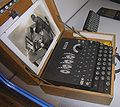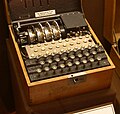Enigma machine
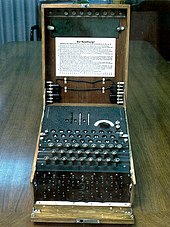
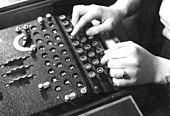
| The Enigma cipher machine |
|---|
| Enigma machine |
| Breaking Enigma |
| Related |
An Enigma machine is any of a family of related electro-mechanical rotor machines used for the encryption and decryption of secret messages. The first Enigma was invented by German engineer Arthur Scherbius at the end of World War I.[1] This model and its variants were used commercially from the early 1920s, and adopted by military and government services of several countries — most notably by Nazi Germany before and during World War II.[2] A range of Enigma models was produced, but the German military model, the Wehrmacht Enigma, is the version most commonly discussed.
The machine has become notorious because Polish mathematicians-cryptographers and then Allied cryptographers were able to cryptanalyze, and thus decrypt, a vast number of messages which had been enciphered using the Enigma. The intelligence gleaned from this source, codenamed ULTRA by the British, was a substantial aid to the Allied war effort. The exact influence of ULTRA is debated, but an oft-repeated assessment is that decryption of German ciphers hastened the end of the European war by two years.[3][4][5]
Though the Enigma cipher had cryptographic weaknesses, in practice it was only in combination with other factors (procedural flaws, operator mistakes, occasional captured hardware and key tables, etc.) that those weaknesses allowed Allied cryptographers to cryptanalyze so many messages.[6]
Description

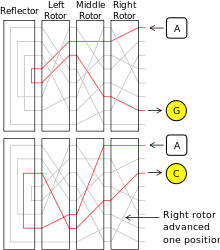
Like other rotor machines, the Enigma machine was a combination of mechanical and electrical systems. The mechanical mechanism consisted of a keyboard; a set of rotating disks called rotors arranged adjacently along a spindle; and a stepping mechanism to turn one or more of the rotors with each key press. The exact mechanism varies slightly from model to model, but the most common form was for the right-hand rotor to step once with every key stroke, and for the other rotors to step occasionally. The continual movement of the rotors results in a different cryptographic substitutions after each key press.
The mechanical parts act in such a way as to form a varying electrical circuit; the actual letter substitution is indicated electrically. When a key is pressed, the circuit is completed; current flows through the various components in their current configuration and ultimately lights one of the display lamps, indicating the output letter. For example, when encrypting a message starting ANX..., the operator would first press the A key, and the Z lamp might light, so Z would be the first letter of the ciphertext. The operator would next press N, and then X in the same fashion, and so on.
To illustrate the detailed operation of Enigma, please refer to the wiring diagram to the left. To simplify the example, only four components of a complete Enigma machine are shown. In reality, there are 26 lamps and keys, several plugs (varied with model) and rotor wirings inside the rotors (at least three were installed). Current flowed from the battery (1) through a depressed bi-directional letter-switch (2) to the plugboard (3). The plugboard allows rewiring of some letter connections between the keyboard (2) and the fixed entry wheel (4). Next, the current wends through the -- unused in this instance, so shown closed -- plug (3) via the entry wheel (4) through the wiring of the three (Wehrmacht Enigma) or four (Kriegsmarine M4 and Abwehr variants) installed rotors (5), and enters the reflector (6). The reflector returns the current, via an entirely different path, through the rotors (5) and entry wheel (4), proceeding through plug 'S' connected with a cable (8) to plug 'D', and another bi-directional switch (9) to light the appropriate lamp.[7]
The repeated changes of electrical paths through an Enigma, because of the rotation of the rotors (which cause the pin contacts to change with each letter typed), implemented a polyalphabetic encryption which provided Enigma's high security.
Rotors

The rotors (alternatively "wheels" or "drums"—Walzen in German) formed the heart of an Enigma machine. Each rotor was a disc approximately 10 cm in diameter made from hard rubber or bakelite with brass spring-loaded pins on one face arranged in a circle; on the other side are a corresponding number of circular electrical contacts. The pins and contacts represent the alphabet—typically the 26 letters A–Z (this will be assumed for the rest of this description). When the rotors were mounted side-by-side on the spindle, the pins of one rotor rest against the contacts of the neighbouring rotor, forming an electrical connection. Inside the body of the rotor, 26 wires connected each pin on one side to a contact on the other in a complex pattern. Most of the rotors were identified by Roman numerals and each issued copy of rotor I was wired identically to all others. The same was true of the special thin beta and gamma rotors used in the M4 naval variant.
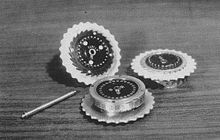
By itself, a rotor performed only a very simple type of encryption—a simple substitution cipher. For example, the pin corresponding to the letter E might be wired to the contact for letter T on the opposite face, and so on. The Enigma's complexity, and cryptographic security, came from using several rotors in series -- usually three or four -- and the regular stepping movement of the rotors, thus implementing a poly-alphabetic substitution cipher.
When placed in an Enigma, each rotor can be set to one of 26 possible positions. When inserted, it can be turned by hand using the grooved finger-wheel which protrudes from the internal Enigma cover when closed. So that the operator can know the rotor's position, each had an alphabet tyre (or letter ring) attached to the outside of the rotor disk, with 26 characters (typically letters); one of these could be seen through the window, thus indicating the rotational position of the rotor. In early Enigma models, the alphabet ring was fixed to the rotor disk. An improvement introduced in later variants was the ability to adjust the alphabet ring relative to the rotor disk. The position of the ring was known as the Ringstellung ("ring setting"), and was a part of the initial setting of an Enigma prior to an operating session. In modern terms it was a part of the session key.
The rotors each contained a notch (more than one for some rotors) which was used to control rotor stepping. In the military variants, the notches are located on the alphabet ring.
The Army and Air Force Enigmas were used with several rotors; when first issued, there were only three. On 15 December 1938, this changed to five, from which three were chosen for insertion in the machine for a particular operating session. Rotors were marked with Roman numerals to distinguish them: I, II, III, IV and V, all with single notches located at different points on the alphabet ring. This variation was probably intended as a security measure, but ultimately allowed the Polish Clock Method and British Banburismus attacks.
The Naval version of the Wehrmacht Enigma had always been issued with more rotors than the other services. At first, six, then seven and finally eight. The additional rotors were marked VI, VII and VIII, all with different wiring, and had two notches cut into them at N and A, resulting in a more frequent turnover.
The four-rotor Naval Enigma (M4) machine accommodated an extra rotor in the same space as the three-rotor version. This was accomplished by replacing the original reflector with a thinner one and by adding a special, also thin, fourth rotor. That fourth rotor was one of two types, "Beta" or "Gamma", and never stepped, but it could be manually placed in any of its 26 possible positions.
Stepping motion

To avoid merely implementing a simple (and easily breakable) substitution cipher, every key press caused one or more rotors to step and so changed the substitution alphabet used for encryption. This ensured the cryptographic substitution would be different at each new rotor position, producing a formidable polyalphabetic substitution cipher.
The most common arrangement used a ratchet and pawl mechanism. Each rotor had a ratchet with 26 teeth and, every time a key was pressed, each of the pawls corresponding to a particular rotor would move forward in unison, trying to engage with a ratchet, thus stepping the attached rotor once. A thin metal ring attached to each rotor upon which the pawl rode, normally prevented this. As this ring rotated with its rotor, a notch machined into it would eventually align itself with the pawl, allowing it to drop into position, engage with the ratchet, and advance the rotor. The first rotor, having no previous rotor (and therefore no notched ring controlling a pawl), stepped with every key press. The five basic rotors (I–V) had one notch each, while the additional naval rotors VI, VII and VIII had two notches. The position of the notch on each rotor could be adjusted.
If this were all the Enigma machine did, rotor one would step 26 times for every step of rotor two and rotor two 26 times for every step of rotor three. However, the design also included a feature known as "double-stepping". This was enabled due to each pawl being aligned with both the ratchet of its rotor and the rotating notched ring of the neighbouring rotor. If a pawl was allowed to engage with a ratchet through alignment with a notch, as it moved forward it would push against both the ratchet and the notch, advancing both rotors at the same time. In a three-rotor machine the double-stepping would affect rotor two only. This, if in moving forward allowed the ratchet of rotor three to be engaged, would move again on the subsequent keystroke, thus resulting in two consecutive steps. Rotor two also pushes rotor one forward after 26 of its steps, but as rotor one moves forward with every keystroke anyway, there is no double-stepping.[8] This double stepping caused the rotors to deviate from odometer style regular motion.
With three wheels and only single notches in the first and second wheels, the machine had a period of 26 × 25 × 26 = 16,900 (not 26 × 26 × 26 because of the double stepping of the second rotor.[8]) Historically, messages were limited to a few hundred letters, and so there was no chance of repeating any net combined rotor position during a single message session, and so cryptanalysts were denied a valuable clue to the substitution used.
To make room for the Naval fourth rotors -- "Beta" and "Gamma", introduced in 1942 -- the reflector was changed, by making it much thinner. The special fourth rotors fit into the space made available. No changes were made to rest of the mechanism, which eased the changeover to the new mode of operation. Since there were only three pawls, the fourth rotor never stepped, but could be manually set into one of its 26 possible positions.
When pressing a key, the rotors stepped before the electrical circuit is connected.
Entry wheel
The entry wheel (Eintrittswalze in German), or entry stator, connects the plugboard, if present, or otherwise the keyboard and lampboard, to the rotor assembly. While the exact wiring used is of comparatively little importance to the security, it proved an obstacle in the progress of Polish cryptanalyst Marian Rejewski during his deduction of the rotor wirings. The commercial Enigma connects the keys in the order of their sequence on the keyboard: QA, WB, EC and so on. However, the military Enigma connects them in straight alphabetical order: AA, BB, CC etc. It took an inspired piece of guesswork for Rejewski to realise the modification.
Reflector
With the exception of the early models A and B, the last rotor came before a "reflector" (German: Umkehrwalze, meaning "reversal rotor"), a patented feature distinctive of the Enigma family amongst the various rotor machines designed in the period. The reflector connected outputs of the last rotor in pairs, redirecting current back through the rotors by a different route. The reflector ensured that Enigma is self-reciprocal: conveniently, encryption was the same as decryption. However, the reflector also gave Enigma the property that no letter ever encrypted to itself. This was a severe conceptual flaw and a cryptological mistake subsequently exploited by codebreakers.
In the commercial Enigma model "C", the reflector could be inserted in one of two different positions. In Model D the reflector could be set in 26 possible positions, although it did not move during encryption. In the Abwehr Enigma, the reflector stepped during encryption in a manner like the other wheels.
In the German Army and Air Force Enigma, the reflector was fixed and did not rotate; there were four versions. The original version was marked A, and was replaced by Umkehrwalze B on 1 November 1937. A third version, Umkehrwalze C was used briefly in 1940, possibly by mistake, and was solved by Hut 6.[9] The fourth version, first observed on 2 January 1944 had a rewireable reflector, called Umkehrwalze D, allowing the Enigma operator to alter the connections as part of the key settings.
Plugboard

The plugboard (Steckerbrett in German) permitted variable wiring that could be reconfigured by the operator (visible on the front panel of Figure 1; some of the patch cords can be seen in the lid). It was introduced on German Army versions in 1930, and was soon adopted by the Navy as well. The plugboard contributed a great deal to the strength of the machine's encryption: more than an extra rotor would have done. Enigma without a plugboard—"unsteckered" Enigma—can be solved relatively straightforwardly using hand methods; these techniques are generally defeated by the addition of a plugboard, and Allied cryptanalysts resorted to special machines to solve it.
A cable placed onto the plugboard connected letters up in pairs, for example, E and Q might be a "steckered" pair. The effect was to swap those letters before and after the main rotor scrambling unit. For example, when an operator presses E, the signal was diverted to Q before entering the rotors. Several such steckered pairs, up to 13, might be used at one time. However, normally only 10 pairs were used at any one time.
Current flowed from the keyboard through the plugboard, and proceeded to the entry-rotor or Eintrittswalze. Each letter on the plugboard had two jacks. Inserting a plug disconnected the upper jack (from the keyboard) and the lower jack (to the entry-rotor) of that letter. The plug at the other end of the crosswired cable was inserted into another letter's jacks, thus switching the connections of the two letters.
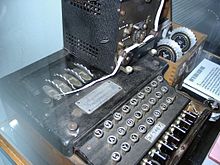
Accessories

A feature that was used on the M4 Enigma was the Schreibmax, a little printer which could print the 26 letters on a small paper ribbon. This did away with the need for a second operator to read the lamps and write the letters down. The Schreibmax was placed on top of the Enigma machine and was connected to the lamp panel. To install the printer, the lamp cover and all light bulbs had to be removed. Besides its convenience, it could improve operational security; the printer could be installed remotely such that the signal officer operating the machine no longer had to see the decrypted plaintext information.
Another accessory was the remote lamp panel. If the machine was equipped with an extra panel, the wooden case of the Enigma was wider and could store the extra panel. There was a lamp panel version that could be connected afterwards, but that required, just as with the Schreibmax, that the lamp panel and lightbulbs be removed.[7] The remote panel made it possible for a person to read the decrypted plaintext without the operator seeing it.
In 1944 the Luftwaffe introduced an extra plugboard switch, called the Uhr (clock). There was a little box, containing a switch with 40 positions. It replaced the default plugs. After connecting the plugs, as determined in the daily key sheet, the operator turned the switch into one of the 40 positions, each position producing a different combination of plug wiring. Most of these plug connections were, unlike the default plugs, not pair-wise.[7] In one switch position, the Uhr did not swap any letters, but simply emulated the 13 stecker wires with plugs.
Mathematical description
The Enigma transformation for each letter can be specified mathematically as a product of permutations. Assuming a three-rotor German Army/Air Force Enigma, let denote the plugboard transformation, denote that of the reflector, and denote those of the left, middle and right rotors respectively. Then the encryption can be expressed as
- .
After each key press, the rotors turn, changing the transformation. For example, if the right hand rotor is rotated positions, the transformation becomes , where is the cyclic permutation mapping A to B, B to C, and so forth. Similarly, the middle and left-hand rotors can be represented as and rotations of and . The encryption transformation can then be described as
- .
Operation
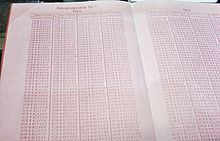
In German military usage, communications were divided up into a number of different networks, all using different settings for their Enigma machines. These communication nets were termed "keys" at Bletchley Park, and were assigned codenames, such as "Red", "Chaffinch" and "Shark". Each unit operating on a network was assigned a settings list for its Enigma for a period of time. For a message to be correctly encrypted and decrypted, both sender and receiver had to set up their Enigma in the same way; the rotor selection and order, the starting position and the plugboard connections must be identical. All these settings (together the key in modern terms) must have been established beforehand, and were distributed in codebooks.
An Enigma machine's initial state, the cryptographic key, has several aspects:
- Wheel order (Walzenlage)—the choice of rotors and the order in which they are fitted.
- Initial position of the rotors—chosen by the operator, different for each message.
- Ring settings (Ringstellung)—the position of the alphabet ring relative to the rotor wiring.
- Plug settings (Steckerverbindungen)—the connections of the plugs in the plugboard.
- In very late versions, the wiring of the reconfigurable reflector.
Enigma was designed to be secure even if the rotor wiring was known to an opponent, although in practice there was considerable effort to keep the wiring secret. If the wiring is secret, the total number of possible configurations has been calculated to be around 10114 (approximately 380 bits); with known wiring and other operational constraints, this is reduced to around 1023 (76 bits).[4] Users of Enigma were confident of its security because of the large number of possibilities; it was not then feasible for an adversary to even begin to try every possible configuration in a brute force attack.
Indicators
Most of the keys were kept constant for a set time period, typically a day. However, a different initial rotor position was chosen for each message, a concept similar to an initialisation vector in modern cryptography, because if a number of messages are sent encrypted with identical or near-identical settings a cryptanalyst, with several messages "in depth", might be able to attack the messages using frequency analysis. The starting position was transmitted just before the ciphertext. The exact method used was termed the "indicator procedure"—weak indicator procedures allowed the initial breaks into Enigma.
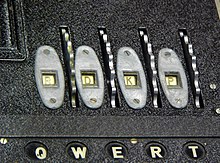
One of the earliest indicator procedures was used by Polish cryptanalysts to make the initial breaks into the Enigma. The procedure was for the operator to set up his machine in accordance with his settings list, which included a global initial position for the rotors (Grundstellung—"ground setting"), AOH, perhaps. The operator turned his rotors until AOH was visible through the rotor windows. At that point, the operator chose his own, arbitrary, starting position for that particular message. An operator might select EIN, and this became the "message settings" for that encryption session. The operator then typed EIN into the machine, twice, to allow for detection of transmission errors. The results were an encrypted indicator—the EIN typed twice might turn into XHTLOA, which would be transmitted along with the message. Finally, the operator then spun the rotors to his message settings, EIN in this example, and typed the plaintext of the message.
At the receiving end, the operation was reversed. The operator set the machine to the initial settings and typed in the first six letters of the message (XHTLOA). In this example, EINEIN emerged on the lamps. By moving his rotors to EIN, the receiving operator then typed in the rest of the ciphertext, deciphering the message.
The weakness in this indicator scheme came from two factors. First, use of a global ground setting—this was later changed so the operator selected his initial position to encrypt the indicator, and sent the initial position in the clear. The second problem was the repetition of the indicator, which was a serious security flaw. The message setting was encoded twice, resulting in a relation between first and fourth, second and fifth, and third and sixth character. This security problem enabled the Polish Cipher Bureau to break into the pre-war Enigma system as early as 1932. However, from 1940 on, the Germans changed the procedures to increase the security.
During World War II, codebooks were only used each day to set up the rotors, their ring settings and the plugboard. For each message, the operator selected a random start position, let's say WZA, and a random message key, perhaps SXT. He moved the rotors to the WZA start position and encoded the message key SXT. Assume the result was UHL. He then set up the message key, SXT, as the start position and encrypted the message. Next, he transmitted the start position, WZA, the encoded message key, UHL, and then the ciphertext. The receiver set up the start position according to the first trigram, WZA, and decoded the second trigram, UHL, to obtain the SXT message setting. Next, he used this SXT message setting as the start position to decrypt the message. This way, each ground setting was different and the new procedure avoided the security flaw of double encoded message settings.[10]
This procedure was used by Wehrmacht and Luftwaffe only. The Kriegsmarine procedures on sending messages with the Enigma were far more complex and elaborate. Prior to encryption with the Enigma, the message was encoded using the Kurzsignalheft code book. The Kurzsignalheft contained tables to convert sentences into four-letter groups. A great many choices were included, e.g. logistic matters such as refueling and rendezvous with supply ships, positions and grid lists, harbor names, countries, weapons, weather conditions, enemy positions and ships, date and time tables. Another codebook contained the Kenngruppen and Spruchschlüssel: the key identification and message key. [11]
Abbreviations and guidelines
The Army Enigma machine used only the 26 alphabet characters. Signs were replaced by rare character combinations. A space was omitted or replaced by an X. The X was generally used as point or full stop. Some signs were different in other parts of the armed forces. The Wehrmacht replaced a comma by ZZ and the question sign by FRAGE or FRAQ. The Kriegsmarine, however, replaced the comma by Y and the question sign by UD. The combination CH, as in "Acht" (eight) or "Richtung" (direction) were replaced by Q (AQT, RIQTUNG). Two, three and four zeros were replaced by CENTA, MILLE and MYRIA.
The Wehrmacht and the Luftwaffe transmitted messages in groups of five characters. The Kriegsmarine, using the four rotor Enigma, had four-character groups. Frequently used names or words were to be varied as much as possible. Words like Minensuchboot (minesweeper) could be written as MINENSUCHBOOT, MINBOOT, MMMBOOT or MMM354. To make cryptanalysis harder, more than 250 characters in one message were forbidden. Longer messages were divided into several parts, each using its own message key. For more details see Tony Sale's translations of "General Procedure"[12] and "Officer and Staff procedure".[13]
History and development of the machine
Far from being a single design, there are numerous models and variants of the Enigma family. The earliest Enigma machines were commercial models dating from the early 1920s. Starting in the mid-1920s, the various branches of the German military began to use Enigma, making a number of changes in order to increase its security. In addition, a number of other nations either adopted or adapted the Enigma design for their own cipher machines.
 |
Commercial Enigma

On 23 February 1918 German engineer Arthur Scherbius applied for a patent for a cipher machine using rotors and, with E. Richard Ritter, founded the firm of Scherbius & Ritter. They approached the German Navy and Foreign Office with their design, but neither was interested. They then assigned the patent rights to Gewerkschaft Securitas, who founded the Chiffriermaschinen Aktien-Gesellschaft (Cipher Machines Stock Corporation) on 9 July 1923; Scherbius and Ritter were on the board of directors.
Chiffriermaschinen AG began advertising a rotor machine—Enigma model A—which was exhibited at the Congress of the International Postal Union in 1923 and 1924. The machine was heavy and bulky, incorporating a typewriter. It measured 65×45×35 cm and weighed about 50 kg. A model B was introduced, and was of a similar construction.[14] While bearing the Enigma name, both models A and B were quite unlike later versions: they differed in physical size and shape, but also cryptographically, in that they lacked the reflector.
The reflector—an idea suggested by Scherbius's colleague Willi Korn—was first introduced in the Enigma C (1926) model. The reflector is a key feature of the Enigma machines.

Model C was smaller and more portable than its predecessors. It lacked a typewriter, relying instead on the operator reading the lamps; hence the alternative name of "glowlamp Enigma" to distinguish from models A and B. The Enigma C quickly became extinct, giving way to the Enigma D (1927). This version was widely used, with examples going to Sweden, the Netherlands, United Kingdom, Japan, Italy, Spain, United States, and Poland.
Military Enigma

The Navy was the first branch of the German military to adopt Enigma. This version, named Funkschlüssel C ("Radio cipher C"), had been put into production by 1925 and was introduced into service in 1926.[15] The keyboard and lampboard contained 29 letters—A-Z, Ä, Ö and Ü—which were arranged alphabetically, as opposed to the QWERTZU ordering.[16] The rotors had 28 contacts, with the letter X wired to bypass the rotors unencrypted.[17] Three rotors were chosen from a set of five[18] and the reflector could be inserted in one of four different positions, denoted α, β, γ and δ.[19] The machine was revised slightly in July 1933.[20]
By 15 July 1928,[21] the German Army (Reichswehr) had introduced their own version of the Enigma—the Enigma G, revised to the Enigma I by June 1930.[22] Enigma I is also known as the Wehrmacht, or "Services" Enigma, and was used extensively by the German military services and other government organisations (such as the railways[23]), both before and during World War II. The major difference between Enigma I and commercial Enigma models was the addition of a plugboard to swap pairs of letters, greatly increasing the cryptographic strength of the machine. Other differences included the use of a fixed reflector, and the relocation of the stepping notches from the rotor body to the movable letter rings.[22] The machine measured 28×34×15 cm (11"×13.5"×6") and weighed around 12 kg (26 lbs).[17]
By 1930, the Army had suggested that the Navy adopt their machine, citing the benefits of increased security (with the plugboard) and easier interservice communications.[24] The Navy eventually agreed and in 1934[25] brought into service the Navy version of the Army Enigma, designated Funkschlüssel M or M3. While the Army used only three rotors at that time, for greater security the Navy specified a choice of three from a possible five.[26]
In December 1938, the Army issued two extra rotors so that the three rotors were chosen from a set of five.[22] In 1938, the Navy added two more rotors, and then another in 1939 to allow a choice of three rotors from a set of eight.[26] In August 1935, the Air Force also introduced the Wehrmacht Enigma for their communications.[22] A four-rotor Enigma was introduced by the Navy for U-boat traffic on 1 February 1942, called M4 (the network was known as "Triton", or "Shark" to the Allies). The extra rotor was fitted in the same space by splitting the reflector into a combination of a thin reflector and a thin fourth rotor.
There was also a large, eight-rotor printing model, the Enigma II. In 1933 the Polish Cipher Bureau detected that it was in use for high-level military communications, but that it was soon withdrawn from use after it was found to be unreliable and to jam frequently.[27]
The Abwehr used the Enigma G (the Abwehr Enigma). This Enigma variant was a four-wheel unsteckered machine with multiple notches on the rotors. This model was equipped with a counter which incremented upon each key press, and so is also known as the "counter machine" or the Zählwerk Enigma.
Other countries also used Enigma machines. The Italian Navy adopted the commercial Enigma as "Navy Cipher D"; the Spanish also used commercial Enigma during their Civil War. British codebreakers succeeded in breaking these machines, which lacked a plugboard. The Swiss used a version of Enigma called model K or Swiss K for military and diplomatic use, which was very similar to the commercial Enigma D. The machine was broken by a number of parties, including Poland, France, Britain and the United States (the latter codenamed it INDIGO). An Enigma T model (codenamed Tirpitz) was manufactured for use by the Japanese.
The Enigma wasn't perfect, especially after the Allies got hold of it, thus allowing the Allies to decode the German messages, which proved vital in the Battle of the Atlantic.
It has been estimated that 100,000 Enigma machines were constructed.[28] After the end of the Second World War, the Allies sold captured Enigma machines, still widely considered secure, to a number of developing countries.[28]
-
Enigma G, used by the Abwehr, had four rotors, no plugboard, and multiple notches on the rotors.
-
The four-wheel Swiss Enigma K, made in Germany, used re-wired rotors.
-
An Enigma model T (Tirpitz)—a modified commercial Enigma K manufactured for use by the Japanese.
Surviving Enigma machines

The effort to break the Enigma was not disclosed until the 1970s. Since then, interest in the Enigma machine has grown considerably and a number of Enigmas are on public display in museums in the U.S. and Europe. The Deutsches Museum in Munich has both the three and four-wheel German military variants, as well as several older civilian versions. A functional Enigma is on display in the NSA's National Cryptologic Museum at Fort Meade, Maryland, where visitors can try their hand at encrypting messages and deciphering code. The Armémuseum in Stockholm in Sweden currently has an Enigma on display. There are also examples at the Computer History Museum in the United States, at Bletchley Park in the United Kingdom, at Polish Army Museum in Poland at the Australian War Memorial, and in foyer of the Defence Signals Directorate, both located at Canberra in Australia, as well as a number of other locations in Germany, the U.S., the UK and elsewhere. The now-defunct San Diego Computer Museum had an Enigma in its collection, which has since been given to the San Diego State University Library. A number are also in private hands. Occasionally, Enigma machines are sold at auction; prices of US$20,000 are not unusual.[29][30]
Replicas of the machine are available in various forms, including an exact reconstructed copy of the Naval M4 model, an Enigma implemented in electronics (Enigma-E), various computer software simulators and paper-and-scissors analogues.
A rare Abwehr Enigma machine, designated G312, was stolen from the Bletchley Park museum on 1 April 2000. In September, a man identifying himself as "The Master" sent a note demanding £25,000 and threatened to destroy the machine if the ransom was not paid. In early October 2000, Bletchley Park officials announced that they would pay the ransom but the stated deadline passed with no word from the blackmailer. Shortly afterwards the machine was sent anonymously to BBC journalist Jeremy Paxman, but three rotors were missing. In November 2000, an antiques dealer named Dennis Yates was arrested after telephoning The Sunday Times to arrange the return of the missing parts. The Enigma machine was returned to Bletchley Park after the incident. In October 2001, Yates was sentenced to ten months in prison after admitting handling the stolen machine and demanding ransom for its return, although he maintained that he was acting as an intermediary for a third party.[31] Yates was released from prison after serving three months.
In October 2008 the Spanish daily newspaper El País reported that 28 Enigma machines were discovered by chance in an attic of the Army headquarters in Madrid during inventory taking. These machines helped Franco's Nationalists win the Spanish Civil War because although the British code breaker Alfred Dilwyn Knox broke the code generated by Franco's Enigma machines in 1937, this information was not passed to the Republicans and they never managed to decipher any of the messages generated by these machines. The Nationalist government continued to use Enigma machines into the 1950s and eventually purchased 50 of them. Some of the original 28 machines are now on display in the Spanish military museums.[32]
Enigma derivatives


The Enigma was influential in the field of cipher machine design, and a number of other rotor machines are derived from it. The British Typex was originally derived from the Enigma patents; Typex even includes features from the patent descriptions that were omitted from the actual Enigma machine. Owing to the need for secrecy about its cipher systems, no royalties were paid for the use of the patents by the British government. A Japanese Enigma clone was codenamed GREEN by American cryptographers. Little used, it contained four rotors mounted vertically. In the U.S., cryptologist William Friedman designed the M-325, a machine similar to Enigma in logical operation, although not in construction.
A unique rotor machine was constructed in 2002 by Netherlands-based Tatjana van Vark. This unusual device was inspired by Enigma but makes use of 40-point rotors, allowing letters, numbers and some punctuation to be used; each rotor contains 509 parts.[33]
Fiction
The play Breaking the Code, by Hugh Whitemore, is about the life and death of Alan Turing, who was the central force in breaking the Enigma in Britain during World War II. Turing was played by Derek Jacobi, who also played Turing in a 1996 television adaptation of the play. The television adaptation is generally available (though currently only on VHS). Although it is a drama and thus takes artistic license, it is nonetheless a fundamentally accurate account. It contains a two-minute, stutteringly-nervous speech by Jacobi that comes very close to encapsulating the entire Enigma codebreaking effort.
Robert Harris' 1995 novel Enigma is set against the backdrop of World War II Bletchley Park and cryptologists working to read Naval Enigma in Hut 8. The book, with substantial changes in plot, was made into the 2001 film Enigma, directed by Michael Apted and starring Kate Winslet and Dougray Scott. The film has been criticized for many historical inaccuracies, including neglect of the role of Poland's Biuro Szyfrów in breaking the Enigma cipher and showing the British how to do it. The film instead gratuitously makes a Pole the villain, who seeks to betray the secret of Enigma decryption.
An earlier Polish film dealing with Polish aspects of the subject was the superficial 1979 Sekret Enigmy (The Enigma Secret).[34]
Wolfgang Petersen's 1981 film Das Boot includes an Enigma machine which is evidently a four-rotor Kriegsmarine variant. It appears in many scenes, which probably capture well the flavour of day-to-day Enigma use aboard a World War II U-Boat.
Neal Stephenson's novel Cryptonomicon prominently features the Enigma machine and efforts by British and American cryptologists to break variants of it, and portrays the German U-boat command under Karl Dönitz using it in apparently deliberate ignorance of its having been broken.
In the comedy war film All the Queen's Men (2001, starring Matt LeBlanc and Eddie Izzard), four World War II Allied soldiers are parachuted into Germany, where, dressed as women, they attempt to steal an Enigma machine. They eventually learn that the Allies already had the machine and that the mission was a ruse intended to mislead the Germans into thinking that Enigma was a closed book to the Allies.
See also
Notes
- ^ Singh, Simon (1999), The Code Book: The Science of Secrecy from Ancient Egypt to Quantum Cryptography, London: Fourth Estate, p. 127, ISBN 1-85702-879-1
- ^ Hakim, Joy (1995). A History of Us: War, Peace and all that Jazz. New York: Oxford University Press. ISBN 0-19-509514-6.
- ^ Kahn (1991).
- ^ a b Miller, A. Ray (2001), The Cryptographic Mathematics of Enigma (PDF), National Security Agency
- ^ Bletchley Park veteran and historian F.H. Hinsley is often cited as an authority for the two-year estimate, yet his assessment in Codebreakers is much less definitive: "Would the [Soviets] meanwhile have defeated Germany, or Germany the Soviets, or would there have been stalemate on the eastern fronts? What would have been decided about the atom bomb? Not even counter-factual historians can answer such questions. They are questions which do not arise, because the war went as it did. But those historians who are concerned only with the war as it was must ask why it went as it did. And they need venture only a reasonable distance beyond the facts to recognise the extent to which the explanation lies in the influence of Ultra." F.H. Hinsley, "Introduction: The Influence of Ultra in the Second World War," Codebreakers: The Inside Story of Bletchley Park, edited by F.H. Hinsley and Alan Stripp, Oxford University Press, 1993, pp. 12–13.
- ^ Kahn (1991), Hinsley and Stripp (1993).
- ^ a b c Rijmenants, Dirk; Technical details of the Enigma machine Cipher Machines & Cryptology
- ^ a b David Hamer, "Enigma: Actions Involved in the ‘Double-Stepping’ of the Middle Rotor," Cryptologia, 21(1), January 1997, pp. 47–50, Online version (zipped PDF)
- ^ Philip Marks, "Umkehrwalze D: Enigma's Rewirable Reflector — Part I", Cryptologia 25(2), April 2001, pp. 101–141
- ^ Rijmenants, Dirk; Enigma message procedures Cipher Machines & Cryptology
- ^ Rijmenants, Dirk; Kurzsignalen on German U-boats Cipher Machines & Cryptology
- ^ "The translated 1940 Enigma General Procedure". codesandciphers.org.uk. Retrieved 2006-10-16.
- ^ "The translated 1940 Enigma Offizier and Staff Procedure". codesandciphers.org.uk. Retrieved 2006-10-16.
- ^ "image of Enigma Type B".
- ^ Kahn, 1991, pp. 39–41, 299
- ^ Ulbricht, 2005, p.4
- ^ a b Stripp, 1993
- ^ Kahn, 1991, pp. 40, 299
- ^ Bauer, 2000, p. 108
- ^ Hinsley and Stripp, 1993, plate 3
- ^ Kahn, 1991, pp. 41, 299
- ^ a b c d Deavours and Kruh, 1985, p. 97
- ^ Michael Smith Station X, four books (macmillan) 1998, Paperback 2000, ISBN 0-7522-7148-2, Page 73
- ^ Kahn, 1991, p. 43
- ^ Kahn (1991, p. 43) says August 1934. Kruh and Deavours (2002, p. 15) say October 2004.
- ^ a b Deavours and Kruh, 1985, p. 98
- ^ Kozaczuk, 1984, p. 28.
- ^ a b Bauer, 2000, p. 112
- ^ Hamer, David; Enigma machines - known locations*
- ^ Hamer, David; Selling prices of Enigma and NEMA - all prices converted to US$
- ^ BBC News | UK | Man jailed over Enigma machine
- ^ Graham Keeley. Nazi Enigma machines helped General Franco in Spanish Civil War The Times 24 October 2008. p 47
- ^ van Vark, Tatjana The coding machine
- ^ Sekret Enigmy (Film 1979) Internet Movie Database
References
- Bauer, F. L. (2000). Decrypted Secrets (Springer, 2nd edition). ISBN 3-540-66871-3
- Hamer, David H.; Sullivan, Geoff; Weierud, Frode (July 1998). "Enigma Variations: an Extended Family of Machines", Cryptologia, 22(3). Online version (zipped PDF).
- Stripp, Alan. "The Enigma Machine: Its Mechanism and Use" in Hinsley, F. H.; and Stripp, Alan (editors), Codebreakers: The Inside Story of Bletchley Park (1993), pp. 83–88.
- Kahn, David (1991). Seizing the Enigma: The Race to Break the German U-Boats Codes, 1939-1943 ISBN 0 395 42739 8.
- Kozaczuk, Władysław, Enigma: How the German Machine Cipher Was Broken, and How It Was Read by the Allies in World War Two, edited and translated by Christopher Kasparek, Frederick, MD, University Publications of America, 1984, ISBN 0-89093-547-5.
- Kozaczuk, Władysław. The origins of the Enigma/ULTRA
- Kruh, Louis; Deavours, Cipher (2002). "The Commercial Enigma: Beginnings of Machine Cryptography", Cryptologia, 26(1), pp. 1–16. Online version (PDF)
- Marks, Philip; Weierud, Frode (January 2000). "Recovering the Wiring of Enigma's Umkehrwalze A", Cryptologia 24(1), pp55–66.
- Smith, Michael (1998). Station X (Macmillan) ISBN 0-7522-7148-2
- Ulbricht, Heinz. Die Chiffriermaschine Enigma — Trügerische Sicherheit: Ein Beitrag zur Geschichte der Nachrichtendienste, PhD Thesis, 2005. Online version.Template:De icon
Further reading
- Calvocoressi, Peter. Top Secret Ultra. Baldwin, new edn 2001. 978-0-947712-36-5
- Cave Brown, Anthony. Bodyguard of Lies, 1975. A journalist's sensationalist best-seller that purported to give a history of Enigma decryption and its effect on the outcome of World War II. Worse than worthless on the seminal Polish work that made "Ultra" possible. See Richard Woytak, prefatory note (pp. 75–76) to Marian Rejewski, "Remarks on Appendix 1 to British Intelligence in the Second World War by F.H. Hinsley," Cryptologia, vol. 6, no. 1 (January 1982), pp. 76–83.
- Garliński, Józef Intercept, Dent, 1979. A superficial, sometimes misleading account of Enigma decryption before and during World War II, of equally slight value as to both the Polish and British phases. See Richard Woytak and Christopher Kasparek, "The Top Secret of World War II," The Polish Review, vol. XXVIII, no. 2, 1983, pp. 98–103 (specifically, about Garliński, pp. 101–3).
- Herivel, John. Herivelismus and the German military Enigma. Baldwin, 2008. 978-0-947712-46-4
- Keen, John. Harold 'Doc' Keen and the Bletchley Park Bombe. Baldwin, 2003. 978-0-947712-42-6
- Large, Christine. Hijacking Enigma, 2003, ISBN 0-470-86347-1.
- Marks, Philip. "Umkehrwalze D: Enigma's Rewirable Reflector — Part I", Cryptologia 25(2), April 2001, pp. 101–141.
- Marks, Philip. "Umkehrwalze D: Enigma's Rewirable Reflector — Part II", Cryptologia 25(3), July 2001, pp. 177–212.
- Marks, Philip. "Umkehrwalze D: Enigma's Rewirable Reflector — Part III", Cryptologia 25(4), October 2001, pp. 296–310.
- Perera, Tom. The Story of the ENIGMA: History, Technology and Deciphering, 2nd Edition, CD-ROM, 2004, Artifax Books, ISBN 1-890024-06-6 sample pages
- Rejewski, Marian. "How Polish Mathematicians Deciphered the Enigma," Annals of the History of Computing 3, 1981. This article is regarded by Andrew Hodges, Alan Turing's biographer, as "the definitive account" (see Hodges' Alan Turing: The Enigma, Walker and Company, 2000 paperback edition, p. 548, footnote 4.5).
- Quirantes, Arturo. "Model Z: A Numbers-Only Enigma Version", Cryptologia 28(2), April 2004.
- Ulbricht, Heinz. Enigma Uhr, Cryptologia, 23(3), April 1999, pp. 194–205.
- Welchman, Gordon. The Hut Six Story: breaking the Enigma codes. Baldwin, new edition, 1997. 978-0-947712-34-1
External links
- Enigma codebreakers ‘saved war for Brits’
- Several images of Enigma
- Detailed photos of various Enigma models and parts
- Cipher Machines & Cryptology Historical and technical details on the Enigma
- Enigma M3 Simulator
- Frode's CryptoCellar various Enigma documents and Breaking Wehrmacht Ciphers
- Bletchley Park National Code Center Home of the British codebreakers durings the Second World War
- Enigma and the Bombe Graham Ellsbury's pages on the breaking of Enigma
- Pictures of a four-rotor naval enigma, including Flash (SWF) views of the machine
- The origins of the Enigma/ULTRA by Dr. Wladyslaw Kozaczuk
- "Enigma rotors: class identification and wiring".
- Enigma Pictures and Demonstration by NSA Employee at RSA
- Enigma machine at Curlie
- Enigma simulation in HTML/Javascript
Template:Link FA Template:Link FA Template:Link FA Template:Link FA Template:Link FA Template:Link FA Template:Link FA

















